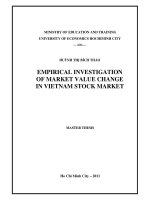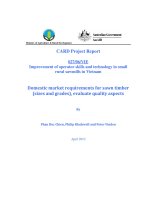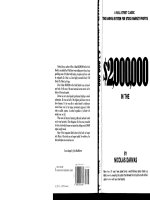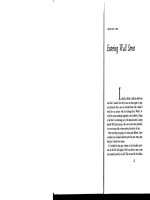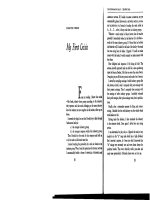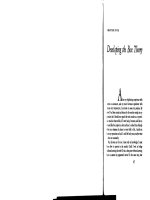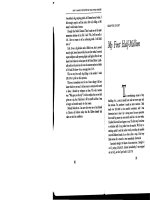Whether momentum or contrarian phenomenon exist in vietnam stock market
Bạn đang xem bản rút gọn của tài liệu. Xem và tải ngay bản đầy đủ của tài liệu tại đây (2.83 MB, 103 trang )
MINISTRY OF EDUCATION AND TRAINING
UNIVERSITY OF ECONOMICS HO CHI MINH CITY
---o0o---
TA THU TIN
WHETHER MOMENTUM OR
CONTRARIAN PHENOMENON EXIST IN
VIETNAM STOCK MARKET
MAJOR: FINANCE – BANKING
MAJOR CODE: 60.31.12
MASTER THESIS
ADVISOR: Ph.D. TRAN PHUONG NGOC THAO
HO CHI MINH CITY, 2011
ACKNOWLEDGEMENT
At first, I would like to express my deep gratitude to my instructor, Dr. Tran Phuong
Ngoc Thao for her intensive guidance and valuable suggestions during time of my study.
I would like to thank Dr. Vo Xuan Vinh for valuable comments and suggestions he share
with me. In addition, I also give my appreciation to all of my lecturers at Faculty of
Banking and Finance, University of Economics Hochiminh City for their teaching and
knowledge during my master course.
My sincere thank goes to Nguyen Hiep Phat, my colleague at Au Viet Securities, he spent
a lot of time to help me make a software program to process raw data in this thesis.
Finally, I am thankful to my family for giving me facilitation to complete my thesis.
i
ABSTRACT
This thesis investigates whether momentum or contrarian phenomenon exist on
Vietnamese Stock Market over the period from January 2005 to June 2011. We employ
the famous methodology by Jegadeesh and Titman (1993) to calculate the profit of
momentum and contrarian strategies which were built base on the historical return of 424
stocks listed on Ho Chi Minh Stock Exchange and Ha Noi Stock Exchange.
We found that all 16 trading contrarian strategies always make abnormal profit with
statistical significance at the level of 10% . The most profitable contrarian strategy with
portfolio based on 6 month formation and 3 month holding has a average monthly return
of 2,829% (equivalent to annually return of 33,95%) with significance level of 2%.
Our research demonstrates that the abnormal profit on trading contrarian strategy can not
be accounted for by beta-risk as well as market size. But we found a evidence of P/B ratio
explaining contrarian phenomenon on Vietnamese Stock Market.
Key words: Momentum; Contrarian strategies.
ii
TABLE OF CONTENTS
ACKNOWLEDGEMENT……………………………………………………………… i
ABSTRACT…………………………………………………………………………….. ii
TABLE OF CONTENTS……………………………………………………………… iii
LIST OF FIGURES……………………………………………………………………. vi
LIST OF TABLES…………………………………………………………………….. vii
ABBREVIATIONS…………………………………………………………………… viii
1. Introduction…………………………………………………………………………. 1
1.1. Overview of Momentum and Contrarian strategies……………………………... 1
1.2. Research Objective……………………………………………………………… 2
1.3. Research Methodology and Scope………………………………………………. 3
1.4. Thesis Structure…………………………………………………………………. 4
1.5. Vietnamese Stock Market……………………………………………………….. 5
2. Literature Review…………………………………………………………………... 7
2.1. Efficient Market Hypothesis……………………………………………………. 7
2.2. Momentum Strategy…………………………………………………………….. 8
2.3. Contrarian Strategy…………………………………………………………….. 15
3. Data Collection and Research Method…………………………………………... 18
3.1. Data Collection………………………………………………………………… 18
3.1.1. Stock Prices…………………………………….……………………….. 18
3.1.2. Adjusted Stock Prices………………………………………………….. 19
3.1.3. P/B ratio………………………………………………………………… 21
3.1.4. Market Capitalization…………………………………………………… 22
3.2. Research Method………………………………………………………………. 22
4. Empirical Result…………………………………………………………………… 24
4.1. Raw Data Processing…………………………………………………………... 24
4.2. Empirical Result……………………………………………………………….. 28
4.3. Why does the contrarian phenomenon exist in Vietnam stock market?.............. 32
4.4. Some factors may account for the contrarian phenomenon in Vietnam Stock
Market…………………………………………………………………………... 35
4.4.1. Market Risk…………………………………………………………….. 36
iii
4.4.2. Firm Size………………………………………………………………... 39
4.4.3. Price to Book……………………………………………………………. 40
5. Conclusion…………………………………………………………………………. 42
5.1. Main findings…………………………………………………………………... 42
5.2. Implications of Research………………………………………………………. 43
5.3. Limitations of Research……………………………………………………….. 44
REFERCENCES……………………………………………………………………… 45
APPENDIX…………………………………………………………………………… 48
Table A1: List of 424 investigated stocks……………………………………………………48
Table B1-Table B16: The average monthly return of Winner and Loser
Portfolios in 16 strategies…………………………………………………………………….. 59
Table C1-Table C16: The average monthly return of Loser portfolio
compare to the one of Winner portfolio in 16 strategies…………………………………. 75
Table D11: Estimation of Beta of Winner portfolio in J=3/K=3 strategy……………… 83
Table D12: Estimation of Beta of Loser portfolio in J=3/K=3 strategy……………….. 84
Table D21: Estimation of Beta of Winner portfolio in J=6/K=3 strategy……………… 85
Table D22: Estimation of Beta of Loser portfolio in J=6/K=3 strategy……….………..86
Table D31: Estimation of Beta of Winner portfolio in J=9/K=3 strategy……………….87
Table D32: Estimation of Beta of Loser portfolio in J=9/K=3 strategy…………………88
Table D41: Estimation of Beta of Winner portfolio in J=12/K=3 strategy……………. 89
Table D42: Estimation of Beta of Loser portfolio in J=12/K=3 strategy……………….90
Table E1: Average Market Capitalisation of Loser portfolio compare to Market
Capitalisation of Winner portfolio in J=3/K=3 strategy…………………………………..91
Table E2: Average Market Capitalisation of Loser portfolio compare to Market
Capitalisation of Winner portfolio in J=6/K=3 strategy…………………………………..91
iv
Table E3: Average Market Capitalisation of Loser portfolio compare to Market
Capitalisation of Winner portfolio in J=9/K=3 strategy…………………………………. 92
Table E4: Average Market Capitalisation of Loser portfolio compare to Market
Capitalisation of Winner portfolio in J=12/K=3 strategy………………………………...92
Table F1: The average P/B ratio of Loser portfolio compare to
the average P/B ratio of Winner portfolio in J=3/K=3 strategy………………………..93
Table F2: The average P/B ratio of Loser portfolio compare to
the average P/B ratio of Winner portfolio in J=6/K=3 strategy……………………….. 93
Table F3: The average P/B ratio of Loser portfolio compare to
the average P/B ratio of Winner portfolio in J=9/K=3 strategy……………………….94
Table F4: The average P/B ratio of Loser portfolio compare to
the average P/B ratio of Winner portfolio in J=12/K=3 strategy……………………...94
v
LIST OF FIGURES
Figure 1.1. VN-Index Chart over the period from July 2000 to September 2011………….6
Figure 3.1. Formation and Holding periods in two strategies……………………………..23
Figure 4.1. The screen of the Analyzing Stock Price Data program
after importing data from Excel file…………………………………………………………….25
Figure 4.2. The screen of the Analyzing Stock Price Data after stocks are
ranked in descending order on the basis of their average monthly returns……………...26
Figure 4.3: The screen of Stock Grouping program shows the Winner
and Loser portfolios, and their average returns……………………………………………..27
vi
LIST OF TABLES
Table 3.1. Adjusting price of KDC share………………………………………………….…..20
Table 3.2. Adjusting price of OPC share………………………………………………….…..21
Table 4.1. The average return of Winner and Loser Portfolios and their difference in
J=3/K=3 Strategy (Formation Period: 3 months; Holding Period: 3 months)……..……28
Table 4.2. Summary of the average monthly return of loser and winner portfolio;
and their differences (profitability of contrarian strategies) for 16 strategies
over the period from 01/2005 to 06/2011……………………………………………….…....30
Table 4.3. Monthly and annually profitability of 16 contrarian strategies
are ranking in descending and their significances………………………………………....31
Table 4.4. Beta coefficient after perform regression………………………………………...38
Table 4.5. The comparison in average market capitalization between
loser and winner portfolios and their differences……………………………………….......39
Table 4.6. The comparison in average P/B ratio between loser and winner portfolios…41
vii
ABBREVIATIONS
CAPM
Capital Asset Pricing Model
EMH
Efficient Market Hypothesis
HOSE
Ho Chi Minh City Stock Exchange
HNX
Ha Noi Stock Exchange
VND
Vietnam Dong
viii
CHAPTER 1: INTRODUCTION
1.1
Overview of Momentum and Contrarian Strategies
In 1970, Efficient Market Hypothesis (EMH) developed by Professor Eugene Fama
proclaimed that in the efficient market no one could consistently beat the market and
stock prices follow a random walk. Thus, future prices of stocks could not be predicted
from their past prices, it means that the abnormal return from trading should be zero.
However, a lot of investors and researchers have doubts about the efficient market
hypothesis both empirically and theoretically. They always try to find some abnormal
returns to prove the inefficiency of the markets.
Consequently, forecasting the price movements in stock markets has become a major
challenge for investors, brokers and speculators. Studying the movement of stock prices
become one of the most attractive fields of research due to its commercial applications
and benefits it offers. Recently, there are many researchers and traders have studied
stock price predictions such as Fundamental Analysis, Technical Analysis, CANSLIM,
etc…
And one of the most attractive trading strategies is momentum (and contrarian) strategy.
The momentum strategy appeared firstly in the 1960s. However, it became widely known
only in the early 1990s after Narasimham Narasimhan Jegadeesh and Sheridan Titman
published their study. Momentum and contrarian strategies are two opposite investment
strategies which use historical price/return data in order to forecast the future
development of stock performance to make excess returns. Momentum investing strategy,
also sometimes known as “Trend following”, believes that stocks which have good
performance in the past will keep doing so in the future, it buys (go long) stocks that have
outperformed in the recent past, and short sell (go short) those that have underperformed
over the same period. In contrast, a contrarian strategy believes that stocks which have
good historical performance will be bad in the future, so it suggests short selling past
winning stocks and buying past losing stock. The contrarian strategy was introduced first
1
by DeBondt and Thaler in 1985, they report that long term past losers outperform long term
past winners over the subsequent three to five years.
After the appearance of this strategy, a lot of studies were carried out to prove or deny
abnormal returns. However, most momentum strategy studies have concentrated
exclusively on the US market and only a few authors have touched on non-US stock
exchanges. Among non-US studies, the majority of papers investigated momentum in
developed markets rather than in emerging markets. As momentum profits may be
explained by market inefficiency, we hypothesize that underdeveloped stock exchanges
may show higher momentum due to their lower efficiency level.
In this thesis we will investigate two types of investment strategies: momentum and
contrarian strategy in the Vietnamese stock market.
1.2
Research Objective
In this thesis we test whether the momentum (or contrarian) strategy make abnormal over
time horizons by examining portfolios which are formed on the historical returns, with
the top decile of the ranked stocks labelled the winner portfolio and the bottom decile
labelled the loser portfolio.
The Efficient Market Hypothesis predicts that these winner/loser portfolios will yield
zero profits, therefore if we find out that the momentum or contrarian momentum exist on
Vietnam Stock Market, we have an evidence prove that Vietnamese Stock Market is not a
weak form of Efficient Market Hypothesis.
This study has three main following objectives:
1. Investigating whether the momentum or contrarian phenomenon exist on the
Vietnamese Stock Market?
2. Determining factors account for the momentum or contrarian phenomenon.
2
Research Questions
Three above research problems lead to the following research questions:
1. Based on historical stock price data in Vietnamese stock market, would
momentum (or contrarian) strategy make abnormal profit?
2. Why does Vietnamese stock market have momentum/contrarian phenomenon?
3. Which factors explain the abnormal return yielded by momentum/contrarian
strategy?
1.3
Research Methodology and Scope
The object of this research is market prices of 424 listed stocks in Ho Chi Minh Stock
Exchange (HOSE) and Ha Noi Stock Exchange over the period from January 2005 to
June 2011.
In this thesis, we use the famous method which was proposed by Narasimhan Jegadeesh
and Sheridan Titman in 1993 to test the profitability of momentum (contrarian) strategies.
In each month we form a winner portfolio with 10% top stocks with highest performance
and loser portfolio with 10% top bottom stocks with lowest performance. Then we make
a comparison the average past return of stocks in the winner portfolio with these in the
loser portfolio in next K months.
In this thesis we use two software programs to analysis data: Analyzing Stock Price Data
and SPSS. Analyzing Stock Price Data is a small software composed by Nguyen Hiep
Phat an Information Technology Engineer working at Au Viet Securities Corporation.
This software ranked stocks ascending based on the average past returns. Next, it build
winner and loser portfolio. The winner portfolios consist of the top decile which
comprises the stocks with the highest performance in the previous J months, and the loser
portfolios consist of the bottom decile which comprises the stocks with the lowest
performance. Then it makes a comparison between the average past return of stocks in
the winner portfolio and these in the loser portfolio.
3
We use SPSS software to perform the paired sample t-test in to make comparison
between the average returns, market sizes and P/B ratios of loser portfolio and these of
winner portfolio. We also use ordinary least square regression in SPSS to estimate
the market risk (beta) of loser portfolio and winner portfolio.
1.4
Thesis Structure:
The thesis goes through 5 following chapters.
Introduction: This chapter introduces research background of the study, research
problems, research objectives, data and research methodology. Furthermore, this chapter
gives a little introduction about Vietnamese Stock Market.
Literature review: This chapter will clarify what has already been observed and
documented in the area of momentum and contrarian phenomena. The literature review
is divided into three main parts in order to consistently illustrate how the previous
researchs are relevant to our study. Firstly, we give an overview of the Efficient Market
Hypothesis. Secondly, we investigate the momentum strategy- buying past winners and
selling past losers. And finally we examine the opposite trading strategy to momentum,
which is widely called contrarian strategy-buying past losers and selling past winners.
Data and Methodology: This chapter divided two part. The data part show how can we
gather market price, market capitalisation and book value per share of stocks and the way
we adjust stock’s market price used in the research. Then we present the method we use
to calculate the profit made by using the momentum (or contrarian) strategies.
Empirical Result: Thi chapter investigates whether the momentum (contrarian) strategy
has existed on the Vietnamese stock market over the period from January 2005 to June
2011. Furthermore, various robustness tests are conducted.
Conclusion: The conclusion sums up on the entire thesis, thereby answering the initial
problem statements, and also giving some recommendations and limitations of this study.
4
1.5
Vietnam Stock Market
To perform the industrialization and modernization process of the country, Vietnam has
been requiring a huge capital. Consequently, building stock market in Vietnam had
become an urgent task to mobilize midterm and long term capital. Furthermore, the
development of stock market helps Vietnam equitize and restructure its state-owned
enterprises.
On July 10th 1998, Prime Minister Phan Van Khai signed a decision to set up two
securities trading centers at Hanoi and Ho Chi Minh City. The first session was launched
on July 28th 2000 at the Ho Chi Minh City Securities Trading Center. And five years
later, in March 2005 the second Hanoi stock trading center (Hastc) was established.
Currently, there are three stock exchanges operating in Vietnam, the Ho Chi Minh Stock
Exchange (HOSE) in Ho Chi Minh City, Ha Noi Stock Exchange (HNX) and UpCom
Market (Upcom stands for Unlisted Public Company Market) in Ha Noi.
As of June 2010, there are 622 listed companies and 4 listed investment funds were
traded on the 3 Vietnamese Stock Exchanges, with a total market capitalization of
VND746.76 trillion (US$39.1 billion- accounted for 40% of GDP).
Thanks to the growth of the stock market, the number of securities companies increased
rapidly during the period from 2007 to 2008. Currently, there are 101 securities
companies registering to be members of HOSE and HNX with total registered capital of
VND 33,340 billion. Most of securities companies have been granted licenses covering
all kinds of businesses: brokerage, dealing on own accounts, underwriting and investment
advisory.
A rapid growth of Vietnamese stock market has attracted many local and foreign
investors, individuals as well as institutions. At the end of August 2011, the number of
investor accounts opened in member securities companies was more than one million in
which foreign investors made up over 15,350 accounts, over 1,000 of which belong to
institutional investors, account for 20% market size.
5
From July 2003, foreign investors were allowed to buy up to 30 percent of the chartered
capital of a listed company. This figure was then raised by to 49 percent at the end of the
third quarter of 2005.
The movement of Vietnamese stock market can be observed clearly via VN-Index’s
changes. Because of the highly speculative nature of Vietnamese stock market, there was
a considerable fluctuation in VN-Index throughout the period from 2005-2011. From
307.5 points in late 2005, VN-Index reach the peak 1,173 points on March 12th, 2007,
then it slipped to 235 points in February 2009. And now VN-Index level off around 400
points. Bellow image illustrates the movement of VN-Index from July 2000 to September
2011.
Figure 1.1: VN-Index Chart over the period from July 2000 to September 2011.
6
CHAPTER 2: LITERATURE REVIEW
This chapter literature review is divided into three main parts in order to consistently
illustrate how the previous studies are relevant to our research. Firstly, we give an
overview of basic knowledge of Efficient Market Hypothesis, CAPM Model. In the
second part, we concentrate to investigate preceding studies about momentum strategy –
buying past winners and short selling past losers. And in the third part we investigate the
opposite trading strategy to momentum – buying past losers and short selling past
winners, this strategy is called contrarian strategy.
2.1 Efficient Market Hypothesis.
One of the most pivotal concepts in finance is the Efficient Market Hypothesis, it was
introduced by Eugene Fama in 1970. Fama defined that an efficient market as one in
which all available information is reflected in the market price. In his publication, Fama
finds statistically highly significant support that stock prices follow a random walk. It is
impossible to consistently outperform the markets by using any historical information the
market already knows. It means that the abnormal return from trading should be zero.
The efficient market hypothesis is closely related to the random walk hypothesis.
Therefore, it can be said that in efficient market stock prices follow a random walk, and
thus future prices cannot be predicted from their past prices. There are three levels of the
efficient market: weak, semi-strong, and strong.
Weak form of efficient market hypothesis: Which says that all past publicly information
contained in past stock price movement is reflected in current market price, nothing is
overvalued or undervalued. The price changes follow a random walk process. It is
impossible to predict future prices by analyzing historical prices. Hence, technical
analysis expert will not be able to make exceed return, reading charts or trend analysis by
technical analysts is just time wasted.
7
Semi strong form of efficient market hypothesis: It is implied that stock prices reflect all
publicly available information about the company’s prospects such as anticipated
earnings, earning announcements, stock issues, the company’s credit rating, the success
of new products… and stock prices will adjust immediately to reflect new public
information. So, excess returns cannot be earned by trading on that information. Semi
strong form of efficient market implies that neither fundamental analysis nor technical
analysis techniques will be able to produce exceed returns.
Strong form of efficient market hypothesis: In this form, all information relevant to the
company is considered as available, even hidden or insider information. And, stock prices
reflect all these information. No investors can earn excess returns as these information
have already been priced. There is evidence for and against the weak and semi-strong
EMH, while there is powerful evidence against strong EMH.
However, a dispute about market efficiency is inevitable. A lot of investors and
researchers have doubts about the efficient market hypothesis both empirically and
theoretically. So they always try to find some trading strategies or methods that yield a
abnormal returns than the market with equivalent risk to prove the inefficiency of the
markets. The financial industry as well, in particular within the asset management, takes a
big interest in finding and exploiting anomalies based on market inefficiency.
2.2 Momentum Strategy
This part will focus on the concept of momentum phenomenon and the development of
momentum research. Momentum is the phenomenon that prices of rising assets tend to
keep rising in the future or that past winners will yield a higher return than past losers.
The following, also presents the empirical findings from a number of studies of
momentum phenomenon and momentum strategies.
Momentum investing strategy, also sometimes known as “Trend following”, basically is an
investing philosophy which is based on a past trend of stock price. Specifically, it is believed
that stocks which have good performance in the past will keep doing so in the near future,
8
then an investment approach that buys stocks that have high returns in recent time and short
sells stocks that have poor returns will outperform the market. This is a investing strategy
based on the underlying belief that stock price trends generally continue for a long period of
time.
The first debut of momentum in stock prices had been conducted by Alexander in 1961.
He examined the behavior of stock prices in speculative bubbles and found that “there are
trends in stock market prices, once the “move” is “taken”. The next remarkable paper was
published by Levy in 1967 who documented that the strategy of buying stocks priced
significantly higher than their average prices over the past 27 weeks generated abnormal
returns.
A next achievement in momentum phenomenon was investigated and proved thoroughly
by Narasimhan Jegadeesh and Titman (1993). They published a significant paper
“Returns to Buying Winners and Selling Losers: Implications for Stock Market
Efficiency” in which they introduced the momentum trading strategy into financial
literature. They analyze the data of American stock prices listed on the NYSE and the
AMEX stocks during the sample period from 1965 to 1989. They concluded that the
strategy based on forming a portfolio while buying the top 10% of stocks with past
highest returns and short selling the bottom 10% of stocks with past lowest return will be
profitable over medium-term (between 3 and 12 months). In this study all returns are
statistically significant, except for the 3M/3M strategy (3 months formation and 3 months
holding) that does not skip a week between the formation and the holding periods. The
most successful momentum strategy in this study is the 12M/3M strategy, which make a
return of 1.31% per month (t=3.74) when there is no time lag between the formation and
the holding periods and 1.49% per month (t=4.28) when there is a 1-week lag between
the formation and the holding periods. The worst strategy is the 3M/3M strategy, which
had the return of 0.32% (t=1.10) without one week lag between the formation and the
holding periods, and 0.73% (t=2.61) with a 1-week lag. The 6M/6M strategy with no
time lag between the formation and the holding periods had an average monthly
momentum return of 0.95% (t=3.07). In general, it seems that strategies with long
9
formation periods of 9 or 12 months and short holding periods of 3 or 6 months perform
somewhat better than the remaining strategies.
Louis K.C. Chan, Narasimhan Narasimhan Jegadeesh, and Josef Lakonishok (1996)
examine the momentum strategy with 6 month formation period over a sample period
from 1977 to 1993 using primarily stocks listed on the NYSE, AMEX, and NASDAQ.
Their results show a momentum return of 8.8% with the 6 month holding period and in
years 1, 2 and 3, the momentum returns are 15.4%, -0.6% and 1.2%, respectively.
In 1998, Conrad and Kaul investigated the momentum strategies which have the length of
the formation and the holding periods spread between 1 week and 36 months. To make a
comparison with Narasimhan Narasimhan Jegadeesh and Titman’ study (1993), Conrad
and Kaul initially investigate stocks listed on the NYSE and AMEX during the period
from 1962 to 1989. They find that, with the exception of the 1-week/1-week strategy, all
other strategies show profitable up to and including the 18M/18M strategy. Therefore,
this results confirm the momentum effect documented by Narasimhan Jegadeesh and
Titman.
In 2001, Narasimhan Jegadeesh and Titman extend the 6M/6M strategy from their
original study with eight additional years. Using data over the 1990 to 1998 sample
period, they find that the momentum strategy continues to be profitable with an average
monthly return of 1.39% (t=4.71) over the 8-year period. They find that momentum effect
exist in both small and large capitalization stocks, but the momentum phenomenon in the
small capitalization stocks is stronger than large capitalization stocks. Basically, the
findings in Narasimhan Jegadeesh and Titman’s second article appear to be very similar
to those in their original study.
Lee and Swaminathan (2000) test the momentum effect over the 1965 to 1995 sample
period using all firms listed on the New York Stock Exchange (NYSE) and American
Stock Exchange (AMEX). Lee and Swaminathan exclude National Association of
Securities Dealers Automated Quotation System (NASDAQ) stocks from their sample, as
10
NASDAQ firms tend to be smaller and thus more difficult to trade in momentum
strategies. They investigate 16 different strategies and find the returns of all zero-cost
portfolios to be positive and statistically significant. To be similar to study obtained by
Narasimhan Jegadeesh and Titman (1993) the 12M/3M strategy turns out to be the most
successful with an average monthly return of 1.54% (t=5.63) over the sample period,
whereas the worst performing strategy turns out to be the 3M/3M strategy with an
average monthly return of 0.66% (t=3.06). Hence, also here the general pattern seems to
be that strategies with relatively long formation periods and short holding periods are to
prefer.
Some finding of momentum phenomenon from European market
In 1998, Rouwenhost published his study in which he examined the profitability of
momentum strategies by using sample data of 2,190 companies from across 12 different
European Markets over the period from 1980 to 1995. Geert Rouwenhorst finds that all
returns of 16 J/K strategies that do not skip time between the formation and the holding
periods are positive and statistically significant at the 5% level. The average monthly
returns range from 0.70% (t=2.59) using the 3M/3M strategy to 1.35% (t=3.97) using the
12M/3M strategy.
Geert Rouwenhorst also found out the best and the worst performing strategies are the
same as Narasimhan Jegadeesh and Titman (1993) investigated on the U.S. market. In
this study Geert Rouwenhorst discover that momentum strategies with long formation
periods of 9 or 12 months and short holding periods of 3 or 6 months tend to perform
better than the remaining strategies.
When comparing the returns of momentum strategies in individual countries, Geert
Rouwenhorst choose the 6M/6M strategy which does not skip time between the
formation and the holding periods as a representative strategy. He finds that, with the
exception of Sweden, all the country-specific returns are statistically significant. The
strongest momentum effect is found in Spain, followed by the Netherlands, Belgium, and
Denmark.
11
He also finds that the momentum phenomenon seem happen to small capitalization, Geert
Rouwenhorst suggests on the basis of his findings that return continuation is stronger in
smaller firms than larger firms in the sample. However, he finds that, although there is a
negative relation between market capitalization and the profitability of the momentum
strategies, past winner stocks tend to significantly outperform than past loser stocks
regardless of the market size of the stocks. This result is consistent with the one found by
Narasimhan Jegadeesh and Titman (1993) on the U.S. market.
Mark T. Hon and Ian Tonks (2002) tested the profitability of momentum trading
strategies in the UK stock market by using historical returns of the largest set of
individual securities in the UK stock market over the period from 1955-1996. They used
strategies with 3, 6, 9, 12, 15, 18, 21 or 24-month formation periods and holding periods
of 3, 6, 9, 12, 15, 18, 21 or 24-months. The results show a total of 24 trading strategies
that are positive and statistically significant at the level of at most 10%. The most
profitable strategy is the 12M/6M momentum strategy with an annualized return of
16.2%.
Their study show that returns on momentum strategies cannot be accounted for by a
simple adjustment for beta-risk. They also find that, there are some evidences of a size
effect in the UK stock market, this phenomenon could not explain the abnormal profit of
momentum effect.
In 2002, Dijk and Huibers (2002) replicate the methodology of Geert Rouwenhorst
(1998) for their analysis of price momentum on stock data from 15 European countries in
the period 1987-1999. They used strategies with 12-month formation periods and holding
periods of 1, 3, 6, or 12 months. Their findings are consistent with Geert Rouwenhorst’s
(1998) and document that momentum strategies are profitable for all the examined
holding periods, also after correction for stock-related risk, book-to-market and size
effects.
Markus Glaser and Martin Weber (2003) also analyze the momentum phenomenon in
German Stock market by using the data comprised of 446 listed on the Frankfurt Stock in
12
the period 1988-2001. Instead of ranking 10 portfolios by stock returns as Narasimhan
Jegadeesh and Titman’s methodology, Markus Glaser and Martin Weber use only 5
portfolios to rank the stocks on the basis of their returns. Markus Glaser and Martin
Weber documents that stocks with a high return will tend to have a higher price
momentum effect, than stocks with a low return. Although they find momentum
strategies to be profitable, the turnover factor has no predictive power among stocks with
a large market capitalization according to their empirical analysis. This entails that
momentum strategy should focus on small capitalization stocks, which are more illiquid
and therefore also costly to trade.
Bird and Whitaker (2003) applied momentum strategies to seven major European
markets over the period from 1990 to 2002. They used these strategies with 6 or 12month formation periods and the holding periods of 1, 3, 6, 9, 12, 24, 36, or 48 months.
For the combined equally-weighted portfolios, Bird and Whitaker find that, with the 6month formation period and the holding periods of up to 9 months, the momentum
strategy make a return of more than 7%. In case of the 12-month formation period, the
optimal holding period is less than 6 months, with the return around 4% for the 6-month
holding period. Both cases of 6 and 12 month formation period, the greatest and most
significant returns are found for holding periods of 3 months and 1 month.
Bird and Whitaker also find that performance of the momentum strategies becomes
negative over longer holding periods. They find the strategy momentum with holding
periods beyond 24 months and 6-month formation period are negative, and the same
result to the strategy using holding periods beyond 12 months and 12-month formation
period.
Finally, Bird and Whitaker investigate the profitability of momentum strategy in each
individual country. They use a formation period of 6 months and holding periods of 6, 9,
or 12 months; and conclude these momentum strategies are profitable in all 7 countries
for all holding periods; however, with a relatively low return on the French and Spanish
markets.
13
Dirk Schiereck (1999) examined the momentum effects of the German stock by alayzing
all stocks listed on the Frankfurt stock exchange in the period from 1961 until 1991. The
set of the formation periods includes 1, 3, 6, and 12 month formation period. His results
are very similar to the ones that Geert Rouwenhorst (1998); Narasimhan Jegadeesh and
Sheridan Titman (1993) reported. The abnormal return of zero cost portfolios with 12
month holding period are 1.49% (t=6.35), 5.52% (t=5.57), 8.07% (t=4.95), and 5.21%
(t=1.87), respectively.
Asian Markets
In 2000, Chui, Sheridan Titman, and Wei investigate the momentum effects on 8 Asian
markets (Hong Kong, Indonesia, Japan, Korea, Malaysia, Singapore, Taiwan, and
Thailand) by using a 6M/6M strategy during the period from 1976 to 2000. The results
showed that the momentum effect is present in all of the Asian countries, except Korea
and Indonesia, but that it is generally weak; and statistically significant in Hong Kong
only. When they combine stocks from all eight countries into one aggregate sample, the
momentum effect still weak and to be statistically insignificant with an average monthly
momentum return of 0.38%. However, when excluding Japan market from aggregate
sample, the momentum effect is quite strong and statistically significant. In general, Chui
et al. find the momentum effect to be relatively stronger for firms with small market
capitalizations, low book t market values, and high turnover ratios.
Kevin R. Foster, Ali Kharazi (2006) studies contrarian and momentum effect on Iran
Stock Market by using data of stock prices over the sample period 1997 - 2002. They
apply the method of Jegadeesh and Titman (2001) and find that there is evidence of
“momentum” where past high ruturn stocks have above average return over an
intermediate (3 - 12 months) horizon. These result show that the stocks in the top decile
tended to outperform the stocks in the lowest decile, by 3 – 11%, depending on the
formation and holding period. The smallest outperformance is for the 3M/3M strategy
with return of 3.07%. The two largest strategies are 9M/6M and 6M/9M strategies which
outperform by 11.07% and 11.05%, respectively.
14
2.3 Contrarian Strategy
The opposite of Momentum strategy is Contrarian strategy. This kind of strategy is based
on the pivotal idea that investors in the stock market tend to overreact to information,
implying that stock prices may also overreact. Overreaction occurs according to Shleifer
(2000, pp. 114–121) when people overreact to unexpected new information, that is, they
are willing to pay an unjustified high price for a security after the arrival of good news,
respectively they are only willing to sell an unjustified low price after bad news. It means
that winner stocks tend to be overvalued while losers stocks are undervalued. Therefore,
contrarian investor can exploit this mentality to obtain financial gains when stock prices
revert to their intrinsic values.
Contrarian strategy literature became widely popular in the late 1980s – early 1990s. The
earliest and most influential evidence of contrarian phenomenon is introduced by Werner
De Bondt and Thaler (1985) who find that contrarian strategy could generate abnormal
returns.
De Bondt and Thaler found that a long term contrarian strategy, which buy losers and sell
winners based on a performance during the 3 to 5 previous years of formation period, will
generate positive returns of nearly 8% per year in the next 3 to 5 year holding periods.
However, many researchers attribute the performance of this contrarian strategy to
investor behavior and result of Bondt and Thaler could be explained by the systematic
risk (beta) of their Loser portfolios. Werner De Bondt and Thaler (1985) note that past
performance can serve as a proxy for investor sentiment, and since prices are initially
biased either by excessive optimism or pessimism, prior losers would make more
attractive investments than prior winners over the long term. Werner De Bondt and
Thaler’s argument is consistent with the hypothesis of long term over reaction by
investors to information—a hypothesis documented in several other markets (e.g.,
Gunaratne and Yonesawa (1997) in Japan, Dirk Schiereck, Werner De Bondt, and Martin
Weber (1999) in Germany).
15
Narasimhan Jegadeesh and Lehmann (1990) reports that a contrarian strategy, based on
information from the previous month, yields statistically significant abnormal returns of
1.99% per month (23.88% per year) over the period 1934-1987 in United State market.
However, other papers argue that their results can hardly be attributed to an overreaction
effect, but are rather caused by a delayed stock price reaction to common factors (Lo &
MacKinlay, 1990), the presence of short-term price pressure or a lack of market liquidity
(Narasimhan Jegadeesh & Sheridan Titman, 1991).
Clare and Thomas (1995), using a sample of 1000 stocks over the period 1995 to 1990 in
the UK stock market, find similar result with De Bondt and Thaler. That is, loser
portfolio outperforms previous winners over a two year period by statistically significant
1.7% per annum. They also find the losers often tend to be small, and the limited
overreaction effect is probably due to the size effect.
Qiwei Chen, Ying Jiang, Yuan Li (2010) investigate contrarian strategies in the Chinese
market, which include all domestic stocks (A shares) listed on both Shanghai and
Shenzhen Stock Exchange
over the period from 1995-2010. They find statistically
significant short term contrarian profit of around 0.8% per month, with 1 to 4 month
holding period based on previous 1 to 2 month formation period. The contrarian strategy
generates higher profit in the period of bear market than in the period of bull market, this
suggests that a contrarian strategy should be used as when the market is in decline.
Tibebe Assefa and Omar Esqueda (2010) investigate the large-cap stocks (their current
market capitalization of five billion U.S. dollars or more) in the United State over the
period from January 1976 to December 2008, and find that both the loser and the winner
portfolios gain in the test periods, but the loser gained more (29.2%) than the winner at
36 months after portfolio formation. In order to explain the differential returns between
the winner and loser portfolios, they further estimate the CAPM for both winner and loser
portfolios. The results indicate that the losers, on average, have lower beta (β=0.98) than
the winners (β=1.29). This result indicates the higher returns of the winner portfolios is
16
